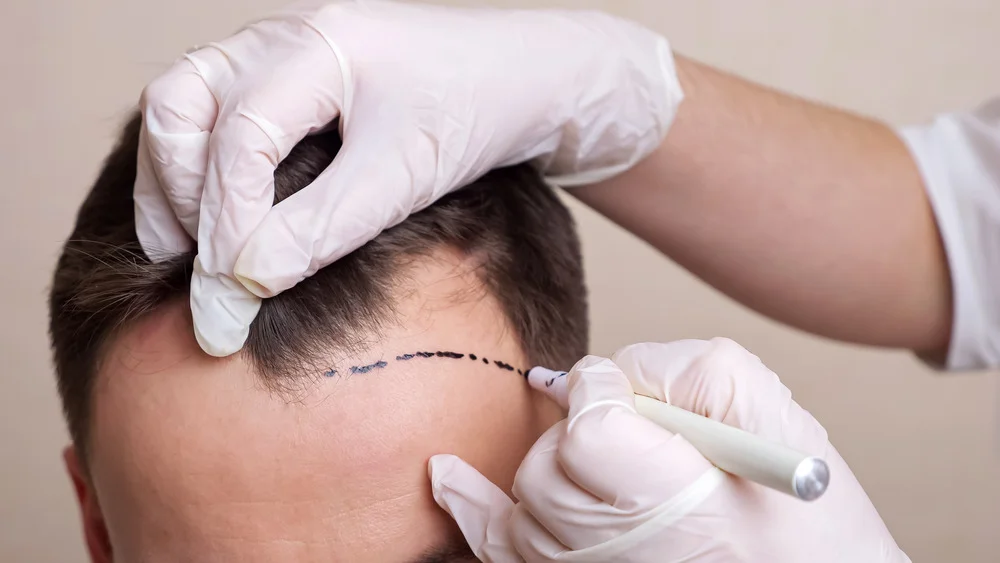Hair loss presents a significant concern for millions globally, impacting self-esteem and quality of life. Current statistics indicate that male pattern baldness affects approximately 85% of men by age 50. Similarly, about 40% of women experience visible hair loss by age 40, according to the American Academy of Dermatology. Fortunately, advancements in medical science offer effective solutions for restoring hair density and natural appearance. Among these, Follicular Unit Extraction (FUE) stands out as a highly sophisticated and widely adopted procedure. This technique has consistently demonstrated superior outcomes for individuals experiencing various degrees of hair thinning. Specifically, the 3000 grafts hair transplant procedure addresses moderate to significant hair loss, delivering comprehensive coverage. This established method provides a reliable path to achieving a fuller head of hair.
Table of Contents
Is 3000 Grafts Enough for Your Hair Loss Pattern?
3000 grafts represent a substantial transplant session that addresses moderate to advanced hair loss patterns effectively. Through our extensive clinical experience, we observe that this graft count typically covers 1000-1200 square centimeters of recipient area, depending on individual hair characteristics and distribution requirements.
Norwood Scale assessment serves as the primary determinant for graft sufficiency:
- Norwood Stage III-IV: 3000 grafts provide comprehensive coverage for frontal recession and crown thinning
- Norwood Stage V: Adequate for restoring hairline and partial crown reconstruction
- Norwood Stage VI-VII: Requires strategic distribution focusing on frontal areas for optimal aesthetic impact
Individual hair characteristics significantly influence transplant outcomes and coverage capacity:
- Hair caliber: Thick hair strands create greater visual density per graft
- Hair texture: Curly or wavy follicles provide enhanced coverage compared to straight hair
- Hair color contrast: Minimal contrast between hair and scalp maximizes perceived density
- Follicular unit composition: Multi-hair grafts yield higher density than single-hair units
Donor area density determines the feasibility of harvesting 3000 grafts safely. Our clinical assessments indicate that patients require minimum 80-100 follicular units per square centimeter in the donor zone to support this extraction volume without compromising future procedures.
Recipient area vascularity and scalp laxity influence graft survival rates and final density achievement. Dense packing techniques allow 35-45 grafts per square centimeter placement, maximizing coverage efficiency within the 3000-graft framework.
Age-related progression considerations affect long-term satisfaction with 3000-graft procedures. Younger patients experiencing active hair loss may require additional sessions to maintain aesthetic balance as pattern baldness advances. Mature patients with stable loss patterns achieve more predictable outcomes with this graft volume. With techniques such as FUT DHI, a 3000 grafts hair transplant can offer a robust option for those seeking significant coverage. These methods ensure a more natural appearance and can enhance patient satisfaction over time.
FUE vs. FUT: Which Technique Works Better for 3000 Grafts?
When selecting between FUE and FUT techniques for a 3000-graft hair restoration procedure, understanding the fundamental differences becomes essential for making an informed decision.
| Aspect | FUE (Follicular Unit Extraction) | FUT (Follicular Unit Transplantation) |
|---|---|---|
| Extraction Method | Individual follicular units extracted using micro-punches | Linear strip of tissue removed from donor area |
| Scarring | Minimal dot scars, virtually undetectable | Linear scar across donor area |
| Recovery Time | 7-10 days for initial healing | 10-14 days, suture removal required |
| Surgical Duration | 6-8 hours for 3000 grafts | 4-6 hours for 3000 grafts |
| Donor Area Management | Preserves donor density effectively | Maximum graft yield per session |
| Hair Length Requirements | Complete shaving of donor area | Partial shaving possible |
FUE demonstrates superior outcomes for patients prioritising minimal scarring and faster recovery. The microsurgical extraction process allows for precise follicular unit harvesting whilst maintaining the integrity of surrounding tissue structures.
Several key factors influence technique selection for 3000-graft procedures:
- Scalp laxity determines FUT suitability, with tighter scalps favouring FUE approaches
- Lifestyle considerations including sports participation and professional requirements
- Hair characteristics such as density, calibre, and natural growth patterns
- Future transplant plans affecting donor area preservation strategies
FUT remains advantageous for patients requiring maximum graft harvesting efficiency within a single session. The technique consistently delivers higher viable graft counts whilst reducing transection rates compared to FUE procedures.
Both methodologies achieve comparable survival rates exceeding 95% when performed by experienced practitioners. The choice ultimately depends on individual anatomical factors, aesthetic preferences, and long-term hair restoration objectives rather than technique superiority alone.
How Much Does a 3000 Grafts Hair Transplant Cost?
The 3000 grafts hair transplant cost varies significantly across different countries and clinics. Based on current market data, patients can expect substantial price differences depending on their chosen destination and clinic reputation.
| Country | Total Cost (£) | 1 Graft of Hair Cost (£) | Technique |
|---|---|---|---|
| United Kingdom | £8,000-£15,000 | £2.67-£5.00 | FUE/FUT |
| Turkey | £2,500-£4,500 | £0.83-£1.50 | FUE |
| Poland | £3,500-£6,000 | £1.17-£2.00 | FUE |
| Hungary | £4,000-£7,000 | £1.33-£2.33 | FUE |
The 3000 grafts hair transplant cost UK represents the premium end of the market, reflecting higher operational costs and stringent regulatory standards. Meanwhile, the 3000 grafts hair transplant cost Turkey offers significant savings without compromising quality, making it a popular medical tourism destination.
Several factors influence the FUE hair transplant 3000 grafts cost:
- Clinic location and reputation
- Surgeon’s experience and qualifications
- Advanced technology and equipment used
- Norwood scale stage complexity
- Additional services included in the package
- Aftercare and follow-up consultations
The 2000 grafts hair transplant cost typically ranges £1,500-£3,000 lower than 3000 grafts procedures, making it essential to determine exact graft requirements before budgeting. Premium clinics often justify higher 3000 hair grafts cost through comprehensive packages including accommodation, transfers, and extended aftercare protocols.
When evaluating the cost of 3000 grafts hair transplant, patients should consider long-term value rather than initial outlay. The 3000 grafts hair transplant price reflects not just the procedure itself but the surgeon’s expertise, facility standards, and post-operative support systems that ensure optimal results.
What to Expect During and After Your 3000 Grafts Hair Transplant?
Understanding the complete journey of your 3000 grafts hair transplant helps set realistic expectations and ensures optimal results throughout the recovery process.
FUE Procedure Timeline for 3000 Grafts
- Pre-operative preparation begins with scalp marking and local anaesthesia administration to ensure patient comfort throughout the procedure.
- Donor area extraction commences with individual follicle removal using specialised micro-punches, typically requiring 4-6 hours for 3000 follicles.
- Graft preparation involves meticulous sorting and preservation of extracted follicles in temperature-controlled solutions to maintain viability.
- Recipient site creation includes making precise micro-incisions in predetermined angles and directions to achieve natural-looking results.
- Implantation process concludes with careful placement of each graft, ensuring proper depth and orientation for optimal growth.
Recovery Process: Day-by-Day Overview
- Day 1-3: Initial swelling and redness around both donor and recipient areas, with prescribed pain medication managing discomfort effectively.
- Day 4-7: Scab formation begins over transplanted grafts whilst swelling gradually subsides, requiring gentle cleansing with provided solutions.
- Day 8-14: Scabs naturally begin loosening and falling off, revealing pink healing tissue underneath the transplanted areas.
- Week 3-4: Most visible signs of surgery disappear, though transplanted hairs may start shedding as part of the normal healing process.
- Month 2-3: Complete healing of recipient sites occurs with minimal visible evidence of the 3000 fue hair transplant procedure.
Visual Progression from Surgery to Final Results
- Immediate post-operative appearance shows 3000 grafts hair transplant coverage with visible recipient sites
- Progressive healing demonstrates gradual integration of transplanted follicles
Initial Shedding Phase
- Shock loss typically occurs 2-4 weeks post-surgery as transplanted hairs enter telogen phase
- Shedding affects 80-90% of transplanted hairs, representing normal physiological response to transplantation trauma
Noticeable Growth Period
- New hair growth becomes visible around month 4-5 with fine, soft texture initially
- Growth rate averages 1cm monthly, gradually increasing in thickness and pigmentation
Maturation and Density Improvement
- Hair density continues improving between months 8-12 as follicles reach full production capacity
- Texture and colour match native hair characteristics progressively during this maturation phase
Achieving Final Results and Long-Term Care
- Final aesthetic outcomes become apparent 12-15 months post-surgery, showcasing complete 3000 hair grafts before and after transformation
- Regular gentle shampooing and UV protection maintain transplant longevity
- Annual follow-up consultations monitor ongoing hair health and detect any potential issues early
Potential Side Effects and Complications with 3000 Grafts Transplants
Hair restoration procedures involving 3000 grafts carry specific risks that patients must understand before undergoing surgery. Clinical evidence demonstrates that proper awareness and preventive measures significantly reduce complication rates in follicular unit extraction procedures.
Shock loss represents the most common temporary side effect, affecting approximately 10-15% of patients. This temporary shedding of existing hair occurs within 2-8 weeks post-surgery. Experienced surgeons minimise this risk through careful recipient site preparation and avoiding excessive trauma to surrounding follicles.
Infection risks remain minimal when proper sterile techniques are employed during the procedure. Post-operative antibiotic protocols and adherence to cleaning instructions effectively prevent bacterial complications. Studies indicate infection rates below 1% in accredited surgical facilities.
Scarring complications can manifest as hypertrophic scars or keloid formation, particularly in predisposed individuals. Surgeons assess patient history and skin type to determine candidacy and implement appropriate healing protocols.
- Bleeding complications occur rarely but require immediate medical attention
- Numbness in donor and recipient areas typically resolves within 3-6 months
- Cyst formation affects less than 2% of patients and responds well to treatment
- Unnatural hairline appearance results from poor planning rather than graft quantity
Swelling and bruising around the forehead and eyes peak 48-72 hours post-surgery. Anti-inflammatory medications and cold compress application effectively manage these temporary effects.
Our extensive experience demonstrates that selecting board-certified surgeons and following comprehensive aftercare protocols dramatically reduces adverse outcomes in follicular transplantation procedures.



